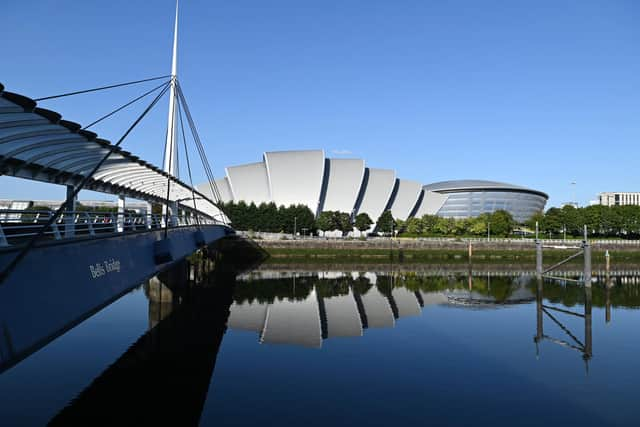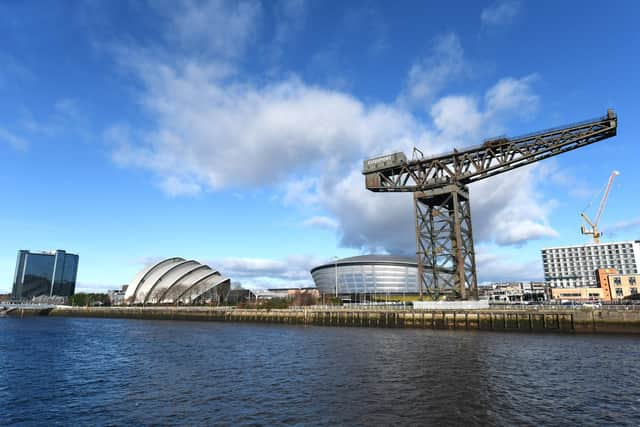Revealed: 'Shocking' carbon footprint of COP26 venues
The SEC Armadillo in Glasgow has been graded F by inspectors, who said its owners should consider installing renewable energy sources as well as new insulation and lighting in order to curb its carbon footprint.
The SEC Centre, the sprawling conference venue which will form the epicentre of negotiations, also has an energy performance certificate (EPC) rating of F. Assessors told its owners in 2012 they should consider investigating the use of low and zero carbon technologies.
Advertisement
Hide AdAdvertisement
Hide AdNine years on, neither it nor any of the other SEC properties have renewable energy sources installed. Cumulatively, the venues, chosen by the UK government for the summit, along with Glasgow Science Centre, are pumping around 6,659 tonnes of CO2 a year into the atmosphere.
With hundreds of world leaders set to descend on Glasgow in November, environmental groups reacted with dismay to the efficiency record of the venues.
Greenpeace warned that COP26 “must be the first climate summit where it’s the rooms themselves that are one of the elephants in the room”. Friends of the Earth Scotland described the energy wastage as “shocking” and “embarrassing”.
The questionable sustainability of the venues will be viewed as an embarrassment for officials in Scotland’s biggest city, as well as both governments in Edinburgh and London. They may also raise eyebrows among United Nations (UN) officials, given its guidance for COP hosts stipulates that the venue “should be an energy-efficient building”, or have energy reduction measures in place. The Madrid venue for COP25, for example, had a purpose-built geothermal power supply for its air conditioning.
Scotland on Sunday can also reveal that authorities across Scotland and the UK are failing to set a good example when it comes to improving energy efficiency in prominent government buildings.


Bute House, the official residence of First Minister Nicola Sturgeon, has an EPC rating of D, while heating-related CO2 emissions at Downing Street have risen for two years running.
It comes as experts warned the issue of energy efficiency across the 220,000 non-domestic buildings in Scotland - a significant source of emissions - have been “overlooked”, and that considerable work is needed to ensure decarbonisation initiatives are successful.
Venue efficiency record ‘embarrassing’
Come November, the eyes of the world will be on the SEC campus, the brainchild of the then Scottish Development Agency, which at the tail end of the 1970s, envisaged transforming the derelict Queens Dock site at Finnieston into a modern exhibition and conference space.


Advertisement
Hide AdAdvertisement
Hide AdThe SEC Centre was completed in 1985, followed by the Armadillo and the SSE Hydro. Together, they will form the tightly-secured, UN-managed blue zone at COP26. The UK government promises the event will have “sustainability at its core”. That pledge, however, is complicated by the venues themselves.
The 3,000 seater Armadillo’s annual emissions are around 1,088,788 kgCO2, according to an EPC assessment carried out September 2019 - the same month it was confirmed Glasgow would host COP26.
Assessors made seven recommendations to improve the building’s efficiency, including the installation of solar water heating, building mounted wind turbines, and solar electricity panels. The following month, an action plan was produced detailing improvements which would cut around a quarter of its annual emissions.
While Covid-19 forced the closure of the Armadillo in March 2020, work has yet to begin against a deadline set for May 2023. Under the Climate Change (Scotland) Act 2009, it is a legal requirement for a building’s owners to evaluate and improve energy efficiency based on the report, known as a section 63 action plan.


The SEC Centre is also rated F on the EPC sliding scale, where A is the best, and G worst. The latest assessment, conducted in 2012, indicated it is emitting 3,421,370 kgCO2 a year. At the time, inspectors advised its owners to “consider investigating the use of low zero carbon technologies”.
The Glasgow Science Centre, set to be taken over by the UK Government for the summit’s green zone, is rated D. Its EPC assessment, issued last April, found it is emitting around 752,719 kgCO2 per year. It noted that the centre has heat pumps in place, but recommended further efficiency measures.
Meanwhile, the latest EPC for the SSE Hydro, which opened just eight years ago, rates it C, with annual emissions of circa 1,396,809 kgCO2.
The carbon footprint of the Clydeside campus is even bigger once the nearby Crowne Plaza hotel is factored in. The hotel, fully booked for COP26, is owned by SEC Ltd and leased at a peppercorn rate. It was rated F last September, with approximate annual emissions of 1,563,634 kgCO2.
Advertisement
Hide AdAdvertisement
Hide AdThe UK government's COP26 Unit, part of the Cabinet Office, referred questions about the venues to the property owners.
A spokeswoman said: “Sustainability will be at the core of COP26. The UK will be offsetting all carbon emissions associated with running the event.


“We are aiming to achieve ISO 20121 certification, which will address all aspects of sustainability of the event including carbon, waste management and supply chain management. We are working with sustainability consultants on this effort.”
The UN Climate Change secretariat did not respond to enquiries from Scotland on Sunday.
But Caroline Jones, Greenpeace UK’s climate campaigner, said: “The Glasgow talks must be the first climate summit where it’s the rooms themselves that are one of the elephants in the room.
“Buildings are directly responsible for more than one sixth of the UK’s total emissions. And while it’s too late to insulate the SEC campus and fit the buildings with heat pumps before COP26 begins, it’s not too late to roll out a deep and thorough strategy that will tackle this problem head on.”
Richard Dixon, director of Friends of the Earth Scotland, said it was “an embarrassment that the buildings hosting the COP are such poor examples”.
He added: “It is shocking that across the SEC campus so much energy is being wasted. Some of the buildings are from the 1980s but the Hydro is less than ten years old and all of them clearly need a major energy efficiency overhaul.
Advertisement
Hide AdAdvertisement
Hide AdMonica Lennon, Scottish Labour’s spokeswoman on net zero and energy, said: “The buildings at the epicentre of the COP26 summit in Glasgow could have been a beacon of net-zero best practice. Instead it’s embarrassing that world leaders will be holding climate talks in venues with an energy efficiency rating as low as F.”
Mark Ruskell, climate spokesman for the Scottish Greens, said: “The fact COP26 will take place in a draughty hall with no renewable energy source underlines the urgent need to address the fact that Scotland’s buildings contribute to our climate emissions, which is why it is a central part of our cooperation deal to enter government.”
Glasgow City Council has ‘big questions to answer’
With eight weeks to go before COP26 begins, preparatory work is underway. Last week, ventilation installers were at the SEC Centre, while a team from the events agency, Identity - who worked at the G7 summit in Cornwall - are planning for one of the largest gatherings of heads of state ever hosted in the UK. Temporary structures are also being erected, with the construction powered by a mix of solar, battery, and mains power.
That work coincides with a return to business as usual. Last weekend, the Armadillo welcomed comedian Daniel Sloss for two gigs - the venue’s first live shows since the initial Covid-19 lockdown. This Tuesday, meanwhile, the campus is hosting the Scottish Sustainability Summit, where attendees will hear how companies can reduce their ecological footprint.
One COP26 venue, at least, is improving its energy efficiency before the conference. Thanks to funding from Scottish Enterprise, £5.5 million worth of work is underway at the Glasgow Science Centre to install new insulation and a heat resistant waterproof membrane to its roof. There will also be a phased replacement of its lighting system to LED, as well as its building management system.
Dr Stephen Breslin, chief executive of the centre, said the improvements will help the venue meet its goal of achieving net zero carbon emissions by 2030.
The timescale for improvements to the three SEC venues, however, is unclear. Planning permission in principle was approved in June for an expansion of the campus, which includes what is described as a “potential energy centre.”
However, mooted technologies like photovoltaic panels, heat pumps and micro wind generation are only under consideration, and the energy centre is only a proposal at present. Much depends on securing private investment. Ironically, the Scottish Environment Protection Agency objected to the campus expansion on the grounds that it may be at medium to high risk of flooding.
Advertisement
Hide AdAdvertisement
Hide AdIn May, SEC Ltd published its environmental policy. In it, Peter Duthie, the firm’s CEO, who was criticised last year over his £266,807 salary package, announced plans to “consider opportunities to make our venue more sustainable”. However, it includes no details about retrofitting renewable technology or carbon management plans.
A spokesman for SEC Ltd said: “We continuously work to make our buildings more energy efficient and are committed to improving our environmental performance. We acknowledge that events can have a substantial impact on the natural and built environment and we are in the advanced stages of developing a sustainability and energy strategy.
“This will consider opportunities to make our venue more sustainable and to identify environmental improvements, innovations and best practices together with a coherent plan for implementation.
He added that since last February, 100 per cent of the electricity used on the campus has come from renewable sources, and that the firm is reducing energy and water wastage, increasing recycling rates, and employing energy efficient technologies. It has also pledged to ensure all packaging it uses will be recyclable or reusable by 2023.
However, Holly O’Donnell, climate and energy policy manager at WWF Scotland, said it was “disappointing” that COP26 had not spurred a wider “energy renovation” at the campus.
“All too often these opportunities get overlooked as too expensive or difficult, and the carbon savings undervalued,” she explained. “But we’ve known for decades that improving the energy efficiency of our old and leaky buildings is the low hanging fruit of climate action, as it cuts carbon but also makes buildings cheaper to run and more comfortable."
The questions over the carbon footprint of the SEC venues are more pronounced given their quasi-public ownership structure. The Armadillo was sold by Glasgow City Council in 2019 to City Property Glasgow (Investments) LLP, one of its arms-length external organisations, to bankroll the council’s equal pay deal.
City Property in turn leases the property back to the council, which sublets it to SEC Ltd for £1.9m a year. SEC Ltd is responsible for the EPC rating and any associated recommendations. The SEC Centre is owned by the council and leased by SEC Ltd until 2047 via a subsidiary firm, while the Hydro is owned by SEC Ltd outright. Some 90.86 per cent of SEC Ltd’s shares are owned by the council - that major financial interest alone, said Lennon, meant that the local authority had “big questions to answer”.
Advertisement
Hide AdAdvertisement
Hide AdSusan Aitken, the council leader, is also a non-executive director on SEC Ltd’s board, while a significant tranche of public money financed the building of the SSE Hydro, with Scottish Enterprise and the council contributing £25m and £15m respectively.
The council has included the SEC expansion in its ‘greenprint’ investment portfolio, which seeks around £30 billion of sustainable investment. Glasgow has already reduced its citywide carbon emissions by 41 per cent since 2006, ahead of a 30 per cent target set for 2020, but its new goals will require significant funds.
Chris Friedler, policy manager for energy efficiency at the Association for Decentralised Energy, said the inefficiency of the landmark venues sat uncomfortably alongside the council’s green ambitions.
“Many other aspects of Glasgow have had low carbon alternatives floated to promote COP26, such as a new fleet of low emission buses, so low efficiency buildings do not send the correct message to the conference,” he said. “This is particularly relevant given that Glasgow City Council has declared a climate emergency with a goal for net zero by 2030.”
Benny Talbot, a spokesman for Stop Climate Chaos Scotland, a civil society coalition of climate change campaigners, added: “The UK government, Scottish Government, and Glasgow City Council have all declared climate emergencies, but none are acting with the urgency that this emergency demands. We all need COP26 to deliver more than warm words and ‘F’ rated action.”
A spokesman for Glasgow City Council said: “If any country or any city was already where it really needs to be, COP wouldn’t be such a critical moment for the planet. No part of the council family would claim, in 2021, to be a fully-formed model of environmental sustainability. Glasgow is, like most cities, closer to the start of its journey than the end.
“Where the city is increasingly seen as a leader, however, is as one living with the legacies of heavy industry and the subsequent economic and social impact of its decline, but also one that is focused on using that experience to seek a just transition to a low carbon economy.”
He added: “COP is important precisely because communities across the world are being confronted with real problems with real and immediate consequences – and cities like Glasgow need significant change in the global economy, as well as national and international policy, to be able to address them.”
Government buildings fail to make the grade
Advertisement
Hide AdAdvertisement
Hide AdThe concerns around energy efficiency extend beyond the COP26 venues, with prominent government properties across Scotland and the rest of the UK lagging behind when it comes to lowering their carbon emissions.
According to the UK government’s December 2020 analysis of its properties, four out of 1,034 buildings across its central estate achieved the best EPC rating of A+. The picture is worse than it was 12 months previously, when 39 buildings met the top grade.
The main building of the Cabinet Office, which is co-ordinating COP26, has an EPC rating of C, and a display energy certificate (DEC) rating - which measures actual energy consumption - of F, the second lowest score. Its electricity-related emissions stood at 1,669 tonnes of CO2 per year as of June, up from 1,457 tonnes two years previously.
Downing Street had a DEC rating of D as recently as 2013, but is now classed as E. Its annual heating emissions increased from 138 tonnes in June 2019 to 174 tonnes this summer.
The main Treasury building and the headquarters of the Department for Environment, Food and Rural Affairs are classed as E, while the Department of Energy & Climate Change scored D.
The Foreign, Commonwealth & Development Office declined to disclose EPC data for its joint headquarters in East Kilbride, claiming it was subject to freedom of information legislation.
Despite those ratings, the UK government’s property agency said it is making progress towards halving office emissions by 2027.
In Scotland, few of the devolved government’s flagship properties could be described as exemplars. Saughton House, inspected last August, was rated D. Assessors ruled that the building’s roof, walls, loft spaces, and glazing are “poorly insulated,” and advised the government to install wind turbines and solar water heating.
Advertisement
Hide AdAdvertisement
Hide AdBute House, the official residence of First Minister Nicola Sturgeon, scored D in July 2019, when inspectors noted poor insulation in the A-listed building’s walls and roofs, as well as the lack of any renewable energy source. Victoria Quay is also rated D.
The government’s headquarters at St Andrews House fares a little better, with a C rating. Recent works on the property include the installation of solar panels, LED lights, and upgraded boilers. Its electricity consumption fell by 44 per cent between 2015 and 2020.
Dixon said that while officials faced an obvious challenge in having so many older properties, they needed to “lead by example” by utilising high levels of insulation and renewable energy systems.
“There are some good examples but they are very much the exception rather than the rule,” he said. “These kinds of improvements need to become mainstream.”
A spokesman for the Scottish Government said: “As a public sector organisation, we are rising to this challenge and are currently developing our own plans for further emissions reduction across our estate and operations.
“We are the only government in the UK to hold the Carbon Trust triple standard, which recognises our significant year-on-year absolute reductions in energy usage, greenhouse gas emissions, water usage, and waste management. Carbon emissions across the Scottish government estate have reduced by 45 per cent over the last 10 years.
Mr Ruskell said his party’s power-sharing deal with the SNP meant that the issue would become even more of a “priority for government.”
“It’s fair to say previous commitments to decarbonise buildings are out of date,” he reasoned. “Part of the £1.8bn secured for decarbonising buildings the Scottish Greens have secured as part of our cooperation agreement will be used to improve the public estate, including Saughton House.”
Energy efficiency crucial to tackling climate crisis
Advertisement
Hide AdAdvertisement
Hide AdThough the issue of energy efficiency struggles to capture the public imagination, it is increasingly important when it comes to the climate crisis; fittingly, a full day of COP26’s programme will focus on the built environment.
According to the International Energy Agency, the right efficiency policies could enable the world to achieve more than 40 per cent of the emissions cuts needed to reach its climate goals, without new technology.
From shopping centres and hospitals to offices and shops, there are around 220,000 non-domestic buildings across Scotland. Cumulatively, they account for around six per cent of the nation’s greenhouse gas emissions; the equivalent UK-wide figure is around 12 per cent.
The Scottish Government’s draft heat in buildings strategy, published in February, notes that 42 per cent of these premises have an EPC rating of G, with a mere five per cent rated B or higher. The government said the strategy would “expand and tighten” existing efficiency requirements.
Professor Paul Ruyssevelt, chair of energy and building performance at University College London’s Energy Institute, stressed that the issue of energy efficiency in non-domestic stock has been “ignored and overlooked for a long time”.
He said. “There’s been a very heavy emphasis on domestic buildings - quite rightly so, as there are more consumers to deal with - but the non-domestic stock is significant and heterogeneous.”
Amid a push to encourage non-domestic property owners to adopt greener measures, there are doubts over whether policies are fit for purpose, and if the capital investment pledged is sufficient.
Ms O’Donnell said a lack of incentives and binding requirements were at the root of the problem, and called for long-term grant support and the rollout of low-carbon urban heat networks.
Advertisement
Hide AdAdvertisement
Hide Ad“We’d like to see requirements to ensure that such buildings meet a minimum standard of energy efficiency starting from 2024,” she explained. “We need both regulations to compel owners to act, as well as supported through grants and incentives to do so.”
Mr Friedler suggested other measures could include mandatory DECs, or a Scottish equivalent, so as to better measure energy performance, backed by “sufficient and measured funding.”
Under the power-sharing agreement ratified between the SNP and the Scottish Greens last month, the policies include a pledge to decarbonise public buildings and invest at least £1.8bn in efficiency upgrades and renewable heating.
The Scottish Government has said that in order for it to meet its targets, an estimated 50,000 non-domestic properties will have to be converted to zero emission heat sources by 2030.
It has yet to produce a detailed plan, but it envisages a phased approach, with SME loan cashback schemes and the use of the non-domestic rates system to encourage owners to use local heat networks and meet upfront transition costs.
Rohinton Emmanuel, professor in sustainable design and construction at Glasgow Caledonian University, said better data was needed to determine the scale of the challenge. He too pointed out that there are no regulatory mechanisms with which to ensure compliance with current energy efficiency standards. “This will need to change if the existing stock is to be made energy, and therefore carbon, efficient,” he said.
The UK government has yet to unveil its much-anticipated heat and buildings strategy, originally slated for publication last summer. The delay, said Mr Ruyssevelt, has been “a bit of a disappointment”.
In its most recent progress report to parliament in June, the Climate Change Committee stressed that there are “critical questions to resolve around who pays for building decarbonisation.”
Advertisement
Hide AdAdvertisement
Hide AdWith no new applicants allowed to access the UK-wide non-domestic renewable heat incentive scheme, which helped businesses meet the cost of installing renewable technologies, a key question is how such transformative improvements can be bankrolled.
Mr Ruyssevelt believes “carrots, sticks, and tambourines” are vital. “It’s about providing incentives, putting regulations in place where they’re required, and making sure people have information and access to knowledge and supply chains.”
He added: “We don’t have a lot of time. I’ve been working in this field for 45 years and I’ve been saying that for the last 30. It’s only now in the twelfth hour that we realise we have to do something.”
A message from the editor:
Thank you for reading this article. We're more reliant on your support than ever as the shift in consumer habits brought about by coronavirus impacts our advertisers. If you haven't already, please consider supporting our trusted, fact-checked journalism by taking out a digital subscription.
Comments
Want to join the conversation? Please or to comment on this article.
